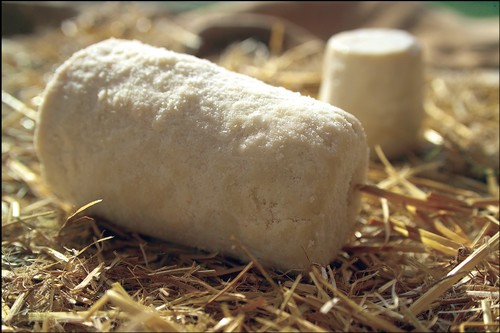Prodotti Tradizionali della Campania
Ricotta essiccata ovicaprina

A Salerno e nei comuni della provincia, è antichissima tradizione produrre la ricotta salata, nei periodi dell’anno in cui c’è molta abbondanza di latte, per cui una parte di essa viene destinata alla stagionatura, in modo tale da ottenere un prodotto da grattugia molto utilizzato per arricchire i piatti tipici locali. La tecnica e gli attrezzi utilizzati ancora oggi sono impiegati secondo regole tramandate di padre in figlio, che non hanno subito alcuna modifica dettata dal progresso tecnologico. È ottenuta dal siero residuo della lavorazione del formaggio, che viene opportunamente riscaldato fino a 85 gradi, temperatura alla quale le proteine del siero si separano sotto forma di piccoli fiocchi che affiorano in superficie costituendo così la ricotta Per la produzione della ricotta, una volta che il siero ha raggiunto la temperatura di 50 gradi, vi si aggiunge del latte fresco in proporzione del 10% circa, al fine di renderla più morbida. La ricotta, lasciata riposare per circa 10 minuti, si estrae con un mestolo forato e si ripone in fuscelle di plastica o di vimini a forma tronco conica. Dopo un periodo di spurgo di circa 24 ore si sala a secco, ricoprendola con sale grosso e girandola più volte per circa 7 giorni. Dopo la fase di salatura la si mette a stagionare per un periodo di 2-4 mesi. In alcune zone la ricotta secca viene conservata in recipienti, completamente ricoperta con crusca di grano, al fine di assicurare un giusto grado di umidità.
![]() In
the Salerno and in its province, the production of salty ricotta is a
very ancient tradition during the times of the year when there is abundance
of milk. A part of it is destined to aging, to obtain a product than
can be grated to enrich local dishes. The technique and the tools are
still to this day used according to rules passed from father to son,
and that have not been modified by technological progress. It is obtained
from the residual whey from the production of cheese. The whey is warmed
to 85C, a temperature at which the proteins of the whey separate in the
shape of flakes that come to the surface making the ricotta. To produce
the ricotta, once the whey has reached a temperature of 50C, 10% of fresh
milk is added, to make it softer. The ricotta is left to rest for ten
minutes, is taken out with a perforated wooden spoon and is placed in
the plastic or wicker fuscelle with a conic shape. After purging to 24
hours the ricotta is salted dry, covering it with coarse salt and turning
it around for 7 days. After the salting it is left to age for 2-4 months.
In some areas dry ricotta is kept in containers, completely covered with
bran grain, to ensure the right grade of humidity.
In
the Salerno and in its province, the production of salty ricotta is a
very ancient tradition during the times of the year when there is abundance
of milk. A part of it is destined to aging, to obtain a product than
can be grated to enrich local dishes. The technique and the tools are
still to this day used according to rules passed from father to son,
and that have not been modified by technological progress. It is obtained
from the residual whey from the production of cheese. The whey is warmed
to 85C, a temperature at which the proteins of the whey separate in the
shape of flakes that come to the surface making the ricotta. To produce
the ricotta, once the whey has reached a temperature of 50C, 10% of fresh
milk is added, to make it softer. The ricotta is left to rest for ten
minutes, is taken out with a perforated wooden spoon and is placed in
the plastic or wicker fuscelle with a conic shape. After purging to 24
hours the ricotta is salted dry, covering it with coarse salt and turning
it around for 7 days. After the salting it is left to age for 2-4 months.
In some areas dry ricotta is kept in containers, completely covered with
bran grain, to ensure the right grade of humidity.